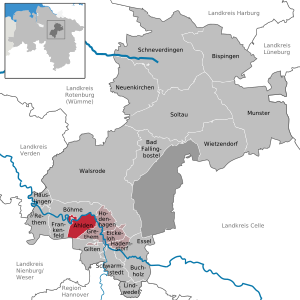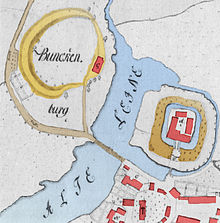Ahlden (Aller)
| coat of arms | Germany map | |
|---|---|---|

|
Coordinates: 52 ° 46 ' N , 9 ° 33' E |
|
| Basic data | ||
| State : | Lower Saxony | |
| County : | Heidekreis | |
| Joint municipality : | Ahlden | |
| Height : | 21 m above sea level NHN | |
| Area : | 25.84 km 2 | |
| Residents: | 1552 (Dec. 31, 2019) | |
| Population density : | 60 inhabitants per km 2 | |
| Postal code : | 29693 | |
| Area code : | 05164 | |
| License plate : | HK | |
| Community key : | 03 3 58 001 | |
| Community structure: | 2 localities | |
| Address of the municipal administration: |
Grosse Strasse 6a 29693 Ahlden (Aller) |
|
| Website : | ||
| Mayor : | Kai Schliekelmann | |
| Location of the municipality of Ahlden (Aller) in the Heidekreis district | ||
Ahlden (All) is a patch in Heidekreis in Lower and a member of community of Samtgemeinde Ahlden .
geography
Ahlden is to the left of the Aller between Celle and Verden and in the middle of the Aller-Leine-Tal tourist region .
The place Eilte belongs to Ahlden.
history
Former place names of Ahlden were Aluthon in the 10th century, Alodun at the beginning of the 11th century and Suleghen et Alethen in the years 1121–1140 Alden, 1153–1170 Alden, 1185 Alethen, around 1200 Alethen, 1239 Aleden, 1250 de Alethen, 1265 Alden, in the 14th century Aldem, Aelden, Aledhen and 1472 Aelden.
The name consists of the root words all (er) for the river and do , a term for "(fortified) settlement, city, place" that is widespread in several Germanic languages (cf. English town , as part of the name -ton for (small) town and Dutch tuin for garden.)
Foundation and office
Ahlden was first mentioned in a document in 1140, when Bishop Siward left the income from Alethen to the nun Rasmoda. In 1160 the nobleman Mirabilis donated parts of his goods in Ahlden to the diocese of Minden (see also Schwarmstedt : History). In 1202 the Ahlden Church was first mentioned in a document. In the 13th century, the noble family of the von Ahlden appeared, whose members have since been often referred to as knights . In a dispute with the diocese and the Guelphs , the Lords of Ahlden lost the castle, the bailiwick and their goods in 1431 . This was the consequence of breaking their promise to stop feuds and raids. But they stayed in the area. The family died out in 1762 with the Rittmeister von Ahlden on Fulde and Südcampen.
In 1431 Ahlden came into the possession of the Duke of Lüneburg, who set up the princely office of Ahlden . It took over the administration and exercised the jurisdiction. The castle also belonged to the office. The facility was headed by a bailiff who collected taxes from the citizens and ran agriculture on the state's own farm, the Vorwerk near the castle. After around 450 years of existence, the Ahlden office was dissolved in 1884 and became part of the Fallingbostel district .
The Merian description from 1654 summarizes the local and castle history as follows:
- Ahlden is a princely Lüneburg administrative building and a small town. Years ago it was granted to the noble family of von Ahlden, but through crimes against the sovereign princes and feudal lords it was drawn in and made into an office. The castle used to stand in a different place between Leine and Aller, which is called Bunkenburg. Duke Christian zu Braunschweig and Lüneburg had the current palace rebuilt in 1613 by Drosten Johann Behren. It is a four-wing complex with beautiful gables, a deep moat and a wall surrounded by a moat. The area is good with beautiful meadows and meadows, fertile fields and oak forests. During wars, the bridges over Aller and Leine were burned down, and in the Thirty Years' War the area itself was burned down too. During this war, imperial officials occupied the castle. It was attacked by 800 men of the Danish occupation from Nienburg, but not captured.
Castle and exile
The development of Ahlden is closely linked to Ahlden Castle , which was built around 1430 and was initially built as a moated castle . Opposite the castle on the other side of the Aller was the Bunkenburg ring wall , which is believed to have originated in the 13th century.
Ahlden Palace served as a place of exile for Sophie Dorothea , the wife of Elector Georg Ludwig of Hanover, from 1694 to 1726 , and King George I of Great Britain from 1714 . Because of her relationship with the Count of Königsmarck , she had to live in solitude until her death as "Princess von Ahlden". After the devastating local fire of Ahlden in 1715, it contributed considerable sums of money to the reconstruction.
The last execution took place in Ahlden in 1749. A foreign thief was hanged for burglary on the Galgenberg outside the village.
The town's Scheunenviertel is characteristic of the town and was first mentioned in 1632 when imperial troops under the direction of Johann T'Serclaes von Tilly burned the town down during the Thirty Years' War . The barns were further destroyed in the great local fires in 1715 and 1847. During the previous great local fire in 1684, only four houses were left standing.
When one barn burned in 1995, it was possible to prevent the fire from spreading to the other barns. Today around 25 barns are still preserved, most of which are in a monumental condition and some are used as residential houses.
The novel Das steinerne Herz (1956) by the writer Arno Schmidt is partly set in Ahlden and uses the location in detail as a backdrop. In 1954 the author made two visits to Ahlden for research. In his honor, a park-like piece of forest with oak trees and rhododendron bushes near the old fire station was named Arno-Schmidt-Hain on August 4, 2001 .
Second World War
Towards the end of the Second World War , members of the 2nd Marine Infantry Division killed the 76-year-old doctor of the village, Dr. Richard without worries and seriously injured Mayor Heinrich Rathge. The division had set up a line of defense against the British military in the neighboring town of Hodenhagen, and at a meeting they remembered the lack of “line loyalty” of some of the leading citizens of Ahlden. In order to settle old bills before the takeover, a scouting party with axes attacked the two on April 14th.
Alternating aller and leash course
Ahlden was originally built on the banks of the Aller , where there was an inexpensive way to cross. At first it was a wooden bridge that was destroyed by acts of war or ice drift. A ferry service was set up later. Today the place is located on an old arm of the Aller, which led Leinewasser from 1618 and has been called "Alte Leine" ever since. This is due to the fact that from 1618 the Aller moved its river bed further east when the water level was high. Then the water of the Leine in the bed of the Aller flowed past Ahlden through a dam construction . From 1648 the course of the river “Alte Leine” changed into an old arm that was drained in places. In 1931 a reinforced concrete bridge was built, which was called the “Blue Bridge” because of its blue paint. In the last days of World War II, the Wehrmacht blew up the bridge when British troops approached. A magistrate was killed in the neighboring castle by debris flying around. After the war, British pioneers built a makeshift bridge that lasted until a new bridge was built in 1960.
On June 11, 1981, the Ahlden area was officially renamed Ahlden (Aller) .
On March 1, 1974, the municipality of Eilte was incorporated.
politics
Mayor of Ahlden is Kai Schliekelmann (FWG).
The municipal council has 11 members (including the mayor). The municipal council election on September 11, 2016 led to the following result:
| list | Share of votes | +/- | Seats |
| CDU | 39.4% | - 1.9% p | 4th |
| SPD | 13.1% | - 8.0% p | 2 |
| FWG | 47.5% | + 13.9% p | 5 |
Culture and sights
- Ahlden Castle
- Ahlden Church
- Bunkenburg as Wallrest
- Arno-Schmidt-Hain named after Arno Schmidt , whose novel The stone heart is set in Ahlden.
- Scheunenviertel
- Jewish cemetery (Ahlden)
Architectural monuments
Arno-Schmidt-Hain with oaks and rhododendrons
Stele from an oak trunk in the Arno-Schmidt-Hain with a symbolized stone heart
Transport and infrastructure
The country road 157 runs through the village. The village has a primary school and various shops.
Personalities
- Ernst Sonnemann (1630–1670), Protestant pastor, hymn poet and editor of the Lüneburg hymn book
- Hermann Rodewald (1856–1938), agricultural scientist, born in Eilte
literature
- Rainer Hendricks: History of the patch Ahlden on the Aller . Ed .: Flecken Ahlden. Walsrode 2006, ISBN 978-3-00-019428-3
- Rainer Hendricks: Historical tour of Flecken Ahlden. Ed .: Flecken Ahlden. Walsrode 2003.
- Hans Freese: From the history of the spot Ahlden, the place of exile of Princess Sophie Dorothea. Walsrode, 1970.
- Heinrich von der Brelie: Eilte - The Chronicle of an Allerdorf. Ed .: Heinrich von der Brelie. Published by Schröder Druck Walsrode, 1998.
- Guido Erol Öztanil: All of this is very much like a novel. Love, murder and exile: The Princess of Ahlden (1666–1726) and a few sideways glances at the history of Ahlden. Walsrode 1994
- Michael Boström: Experienced stories 1945–1956, read history 1341–1945 in Ahlden. Walsrode 2008.
- Alice Schmidt : Diary from 1954. Suhrkamp Verlag, Frankfurt am Main 2004, ISBN 3-518-80220-8
- Arno Schmidt : The stone heart. Karlsruhe 1956 (first complete version: Zurich 1985).
- Hans-Cord Sarnighausen: Local lawyers from 1682 to 1866 in Ahlden (Aller), in: GENEALOGIE, Verlag Degener & Co., Issue 3/2009, pp. 631–651.
Web links
Individual evidence
- ↑ State Office for Statistics Lower Saxony, LSN-Online regional database, Table 12411: Update of the population, as of December 31, 2019 ( help ).
- ^ Jürgen Udolph (research): The "place name researcher". In: website NDR 1 Lower Saxony . Archived from the original on December 7, 2015 ; accessed on August 2, 2019 .
- ↑ Chronicle Ahldens on jpf.de
- ↑ a b Federal Statistical Office (ed.): Historical municipality register for the Federal Republic of Germany. Name, border and key number changes in municipalities, counties and administrative districts from May 27, 1970 to December 31, 1982 . W. Kohlhammer, Stuttgart / Mainz 1983, ISBN 3-17-003263-1 , p. 224 and 241 .
- ↑ Municipal Council at www.ahlden.info
- ↑ Inauguration of the Arno-Schmidt-Grove in Ahlden 2001










